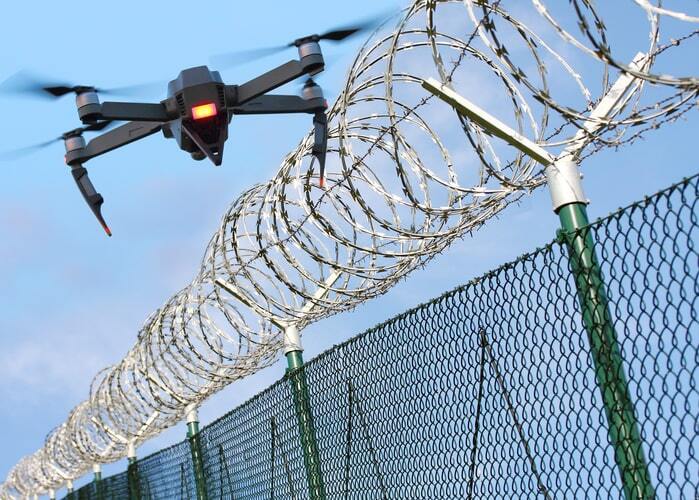Summary: When a drone flies over a prison, detection alone isn’t enough—effective protection depends on clear, practiced response tactics and coordination with law enforcement.
Facilities must first define their objectives: whether to prioritize recovering the drone and contraband or apprehending the pilot behind the operation.
Response plans should account for factors like staffing levels, time of day, and local drone activity, with trained personnel or K-9 units ready to act quickly.
Properly configured detection systems paired with swift, consistent responses deter future incidents and have led some prisons to see a complete halt in drone-based contraband deliveries.
When a drone is operated over a prison, the primary objective is to find the pilot quickly. The goal of a drone detection system is to help with that, but also to prevent future attempts. But this doesn’t happen without swift and consistent prison personnel response to system alerts to serve as a deterrent.
Response Tactics for a Drone Over Your Prison
Arriving at your drone response tactics is a process. Drone detection objectives and desired outcomes should be fully explored before technology deployment because they will drive how the technology should be configured and deployed.
Is it more important to locate the pilot or the drone when a drone is over a prison?
When a prison detects drone and/or controller (pilot) signals, is the priority to find and confiscate the drone and its payload or to apprehend the pilot? The immediate need to prevent the contraband from entering the prison facility must be balanced with the need to disrupt the larger contraband supply chain. Whatever the priority, the prison must determine how and which personnel will respond to drone incidents.
Should drone response tactics always be the same?
Drone response tactics when a drone is over a prison may vary by time of day. For example, if there is an incident while inmates are outside in the yard, the warden may put the prison on lockdown until a search, including the rooftops, has been completed.
Prison facilities may vary response tactics and add resources if there is advanced intel that a prison drone drop is scheduled. Drone pilots tend to operate as far away from the facility as possible and often test facility response when they know drone detection systems are in place.
Who Responds to Prison Drone Incidents?
Once the response priorities are set, a facility examines the resources available and determines who is best to respond under what circumstances.
If the prison facility has a response or special operations team available 24/7, it is important to evaluate whether their typical response time is within the window to react to drone incidents. Some drone prison deliveries may be quick single-drone, single deliveries, while others may be sophisticated operations with lookout and decoy drones running multiple large-scale deliveries.
Some correctional facility staff are peace officers and can arrest contraband drone pilots themselves, while others need to rely on local law enforcement to find and apprehend the pilots.
Prison facilities with K-9 teams may dispatch the dogs to track the drugs and a separate team to track and apprehend the pilot.
There is no one-size-fits-all response strategy to drones over prisons. Each facility must consider different scenarios, determine its goals and objectives, and then configure the system to support accordingly.
Who Gets Access to the Prison Drone Detection System?
While who gets access to the drone detection system seems a simple decision, several complexities drive the final decision.
If the correctional staff is suspected of corruption, the drone detection system may not even be made known to staff. Or if a facility is severely understaffed, as many are these days, alerts can be instead provided to the warden, a trusted employee, a regional command, or even local law enforcement.
Secondary alerts ensure the system cannot be “turned off” temporarily for a drone delivery.
Correctional facilities may opt to provide direct law enforcement notifications, or the facilities may want their staff to investigate and call in law enforcement when necessary.
What to do When a Drone is Detected Over Your Prison?
When a drone detection alert is received, whoever is responsible for dispatching a response team should carefully review the system to assess the threat situation. For example, if the drone has not crossed over the prison facility property, they may want to simply monitor.
A facility’s pan, tilt, zoom cameras can be used to visually confirm the drone and/or pilot location to help guide the response team dispatched by the command center.
During initial system deployment, it is critical to work closely with the team that monitors the system to establish a process to investigate signals before a response team is dispatched.
Prison facilities located in suburban neighborhoods where kids or realtors fly drones, near farmers who fly drones to check on crops, or even near a recreational flight club, should establish at what distance from the facility they want to receive drone detection alerts.
Drones are notoriously difficult to see with the human eye so just because staff cannot see a drone, they should not assume it is not there. At night, contraband drone pilots often tape the lights to avoid visual detection, which makes them all the more difficult to see.
What Information Should I Collect as Evidence of a Drone Incursion Over My Prison?
A drone detection system will automatically collect and store information such as the date and time both devices were detected, and where they traveled.
According to a federal advisory on drone detection technology use, systems cannot extract the drone’s make/model and serial number, as this violates federal wiretapping laws. However, a system that receives Remote ID broadcasts provides:
- Drone’s unique ID number or serial number (similar to a license plate)
- Drone’s current location (latitude/longitude, altitude, velocity)
- Drone’s takeoff location (control station or launch point)
- Timestamp of the broadcast
A drone detection system that provides a flight path history that can be evaluated and used in reporting afterwards is beneficial in many ways.
- Incident reports can be crucial for prosecution and response planning improvement.
- Other reports can be used to discover trends, such as common days/times for attempted contraband deliveries.
We are not legal experts on drone and pilot confiscation/apprehension. The actions you can take will vary by state and local laws and where your facility is located. You need to consider whether you can legally confiscate the drone once it has been recovered.
Conclusion - Dealing with Drones over Prisons
Prison facilities that deployed drone detection coupled with solid response tactics that have led to disrupted drone deliveries have seen a complete cessation of drone contraband deliveries.
Drone pilots have been arrested with regular delivery route books, which indicates that rather than risk contraband confiscation and arrest, they can simply avoid facilities that have deployed drone detection systems.
A drone detection system is the foundation for preventing contraband deliveries into prisons. However, prevention relies on a solid process that includes proper configuration and response tactics.
Do not wait to determine how you will respond to drone detection system alerts after you have already deployed a technology. Drone detection objectives may vary by facility, region, relationship with local law enforcement, and other factors. Priorities, tactics, and response protocols for pilot/controller apprehension will also drive how technology should be configured and deployed.
Drone Over Prison FAQs
What should I do if a drone is flying over my prison?
When a drone is detected over a prison, the top priority is to locate the pilot and prevent any contraband delivery. If your facility has cameras, they can be used to confirm the detection. Security teams should immediately review the detection data and coordinate with internal resources or law enforcement for a safe and legal response.
Why is detecting a drone over a prison not enough?
Detection provides awareness but not prevention. Without trained personnel, clear response roles, and coordination protocols, even the best detection systems can’t stop contraband drops or future incursions. Effective deterrence depends on rapid, consistent responses.
How can prisons locate a drone pilot?
Radio frequency-based drone detection systems can pinpoint both the drone and its pilot’s location. This allows staff or police to intercept the operator—often the key to disrupting larger contraband networks.
Should the prison always respond the same way to drone detections?
No. Response tactics may vary depending on the time of day, inmate activity, and intelligence about potential drops. For example, a daytime yard incident may require lockdown, while an overnight detection might focus on locating the pilot before contraband is retrieved.
Who should have access to the prison’s drone detection system?
Access should be limited to trusted personnel or law enforcement. In cases where staff corruption is suspected or staffing is limited, alerts can be routed to wardens, regional command centers, or police to ensure accountability and uninterrupted monitoring.
What evidence should be collected when a drone flies over a prison?
Detection systems automatically log date, time, flight path, and location data. This information—along with video or photo evidence—can be used in investigations and prosecutions to identify trends or repeat offenders.
Is it legal for prisons to confiscate or disable drones?
No. Federal law prohibits anyone except authorized federal agencies from disabling, jamming, or destroying drones. Facilities can recover a landed drone if it’s on their property, but any action should comply with state and local laws.

